Victor Hugo🎨, in The Hunchback of Notre-Dame:
"A vast symphony in stone, so to speak; the colossal work of one man and one people, all together one and complex, like the Iliads and the Romanceros, whose sister it is; prodigious product of the grouping together of all the forces of an epoch, where, upon each stone, one sees the fancy of the workman disciplined by the genius of the artist start forth in a hundred fashions; a sort of human creation, in a word, powerful and fecund as the divine creation of which it seems to have stolen the double character - ariety, eternity".
"A vast symphony in stone, so to speak; the colossal work of one man and one people, all together one and complex, like the Iliads and the Romanceros, whose sister it is; prodigious product of the grouping together of all the forces of an epoch, where, upon each stone, one sees the fancy of the workman disciplined by the genius of the artist start forth in a hundred fashions; a sort of human creation, in a word, powerful and fecund as the divine creation of which it seems to have stolen the double character - ariety, eternity".
Sylvius Paoletti (1864-1921) Notre Dame de Paris, 1907








